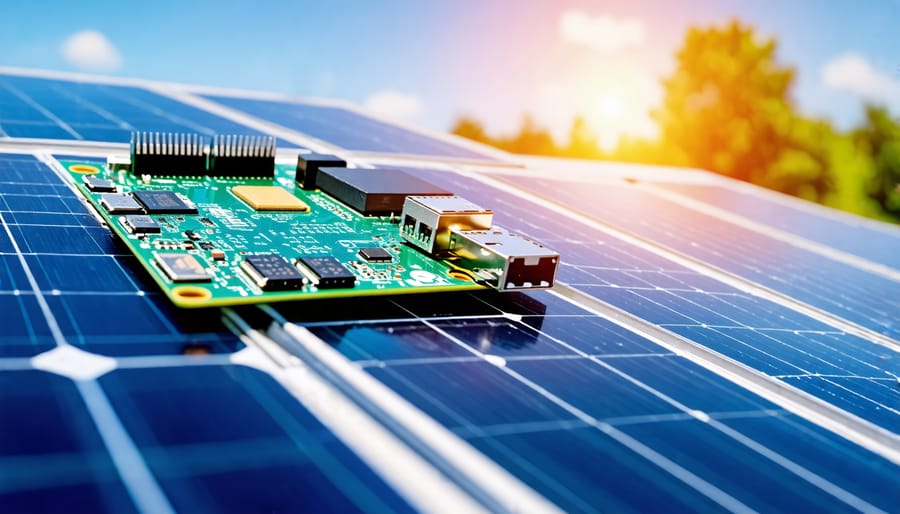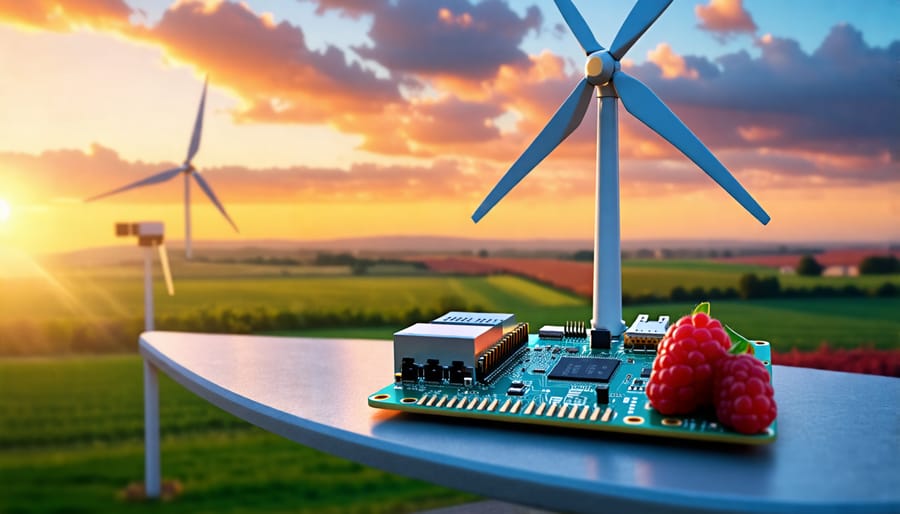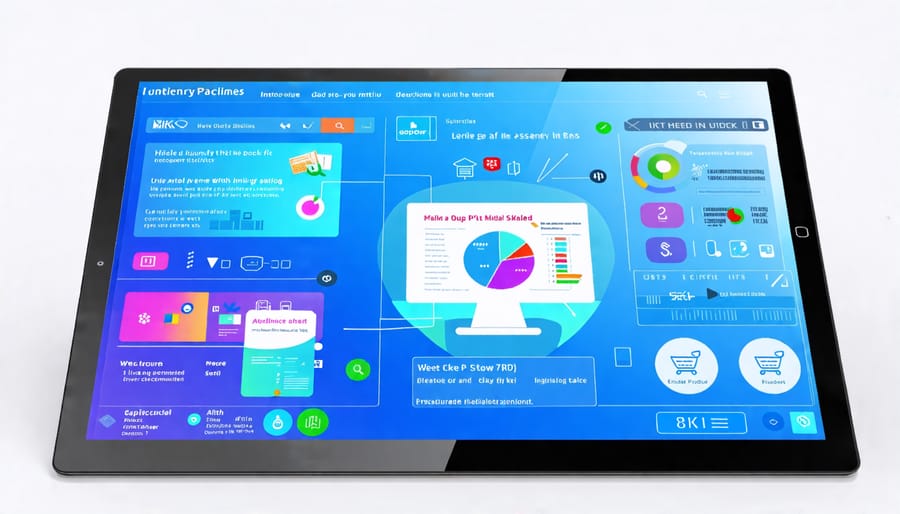Inspire the next generation of clean energy innovators with these 5 engaging Raspberry Pi projects that teach key renewable energy concepts. Build a solar-powered Raspberry Pi weather station to monitor environmental conditions and understand solar panel efficiency. Create a wind turbine generator using a Raspberry Pi to explore wind energy principles. Develop a smart home energy monitoring system that tracks usage and promotes conservation. Simulate a micro-grid with multiple Raspberry Pis to learn about load balancing and energy distribution. Design an interactive renewable energy educational game to make learning fun and accessible. With these hands-on projects, students will gain practical skills, deepen their understanding of renewable energy technologies, and be inspired to tackle real-world energy challenges. Empower your students to become the innovative problem-solvers our planet needs by incorporating these Raspberry Pi renewable energy projects into your curriculum today.
Solar-Powered Weather Station
Building a solar-powered Raspberry Pi weather station is an exciting project that combines renewable energy and IoT technology. To get started, you’ll need a Raspberry Pi board (we recommend the Raspberry Pi 4), a solar panel, a battery pack, a charge controller, and various weather sensors such as a temperature and humidity sensor (like the DHT22), a wind speed sensor, and a barometric pressure sensor (like the BMP280).
Begin by setting up your Raspberry Pi with the latest version of Raspberry Pi OS and connecting the weather sensors to the GPIO pins. For example, connect the DHT22 to GPIO 4 and the BMP280 to the I2C bus. You can also add a Raspberry Pi High-Quality Camera to capture images of the weather conditions.
Next, write a Python script to read data from the sensors and log it to a file or database. Here’s a sample code snippet for reading temperature and humidity from the DHT22:
“`python
import Adafruit_DHT
sensor = Adafruit_DHT.DHT22
pin = 4
humidity, temperature = Adafruit_DHT.read_retry(sensor, pin)
if humidity is not None and temperature is not None:
print(f”Temperature: {temperature:.1f}°C, Humidity: {humidity:.1f}%”)
else:
print(“Failed to retrieve data from the sensor”)
“`
To power your weather station using solar energy, connect the solar panel to the charge controller and the battery pack. The charge controller will regulate the power from the solar panel to safely charge the battery and power the Raspberry Pi. You can also add a voltage sensor to monitor the battery level and optimize power consumption.
Finally, create a web interface or dashboard to display the weather data in real-time. You can use web frameworks like Flask or Django to create a responsive and user-friendly interface. Consider adding data visualization tools like charts and graphs to help users better understand the weather patterns over time.
With this solar-powered Raspberry Pi weather station, you’ll be able to monitor local weather conditions while learning about renewable energy and IoT technology. Feel free to expand on this project by adding more sensors, implementing machine learning algorithms for weather prediction, or integrating with other smart home devices.

Wind Turbine Energy Monitor
In this engaging project, students will create a Raspberry Pi-based system to monitor the energy output of a model wind turbine. To begin, you’ll need a Raspberry Pi, a voltage sensor, a current sensor, and a model wind turbine. Connect the sensors to the Raspberry Pi’s GPIO pins and the turbine’s output.
Next, write a Python script to read the sensor data and calculate the instantaneous power output using the formula: Power (W) = Voltage (V) × Current (A). Store these values in a CSV file along with a timestamp for each reading.
To visualize the data, use a library like Matplotlib to create a graph of the power output over time. This will help students understand how the turbine’s performance varies with wind speed and identify any patterns or trends.
For a more advanced version, incorporate an anemometer to measure wind speed and correlate it with the power output. You can also add a web interface using Flask to display real-time data and historical graphs.
Throughout the project, encourage students to think critically about the factors affecting wind turbine efficiency, such as blade design, generator type, and wind conditions. By building this monitoring system, they’ll gain hands-on experience with sensors, data logging, and data visualization while exploring the principles of renewable energy.
This project is an excellent opportunity to discuss the importance of wind energy in the transition to a sustainable future and inspire students to pursue careers in the field. With the skills and knowledge gained from this project, they’ll be well-equipped to tackle more complex renewable energy challenges in the future.

Renewable Energy Data Logger
Building a Raspberry Pi data logger to track the performance of your renewable energy projects, such as solar panels or wind turbines, is an excellent way to gain insights into their efficiency and output over time. To get started, you’ll need a Raspberry Pi, sensors to measure voltage and current, and a compatible analog-to-digital converter (ADC) to read the sensor data.
Once you have the hardware set up, you can use Python libraries like RPi.GPIO and ADCDevice to read the sensor data and store it in a database or file format of your choice. SQLite is a lightweight, file-based database that works well for local data storage on the Raspberry Pi.
To analyze and visualize the collected data, you can use Python libraries such as Pandas for data manipulation and Matplotlib or Plotly for creating graphs and charts. These libraries allow you to create insightful visualizations of your renewable energy system’s performance, such as daily energy production, average output over time, and comparisons between different days or seasons.
For a more advanced setup, you can integrate your Raspberry Pi data logger with cloud platforms like Google Sheets or ThingSpeak. This enables you to access and analyze your data remotely, share it with others, and create live dashboards to monitor your system’s performance in real-time.
By building a renewable energy data logger, you’ll not only learn about Raspberry Pi programming and data analysis but also gain valuable insights into the performance of your renewable energy projects. This hands-on experience will deepen your understanding of clean energy technologies and inspire you to explore further optimizations and improvements for your systems.
Smart Home Renewable Energy Controller
Learning about renewable energy is crucial for students as we move towards a more sustainable future. A hands-on project that combines renewable energy concepts with the versatility of a Raspberry Pi is an excellent way to engage students and foster their understanding of these technologies.
In this project, students will create a smart home renewable energy controller using a Raspberry Pi. The controller will optimize the usage of renewable energy sources, such as solar and wind power, in a model smart home. By integrating weather data and simulated energy consumption patterns, the controller will make intelligent decisions to balance the energy mix, prioritizing renewable sources when available.
Students will set up sensors to monitor weather conditions and energy generation from the model solar panels and wind turbines. They’ll also simulate energy consumption data for various household appliances. The Raspberry Pi will be programmed to analyze this data in real-time, making decisions to switch between renewable sources and a backup battery or grid connection as needed.
Throughout the project, students will learn about the advantages and challenges of renewable energy integration, energy storage solutions, and the role of student learning in programming and data analysis. They’ll gain hands-on experience with setting up the Raspberry Pi, connecting sensors, and writing code to control the energy management system.
By completing this project, students will develop a deeper understanding of how renewable energy can be effectively harnessed and managed in a residential setting. They’ll also gain valuable skills in programming, data analysis, and problem-solving, which are essential for tackling real-world challenges in the renewable energy sector.
Renewable Energy Education Kiosk
Creating an interactive Raspberry Pi kiosk is an excellent way to educate others about renewable energy in a hands-on, engaging manner. With a touchscreen display, you can design an intuitive interface that allows users to explore various aspects of renewable energy through quizzes, videos, and real-time data from other projects.
To get started, you’ll need a Raspberry Pi, a touchscreen display, and a suitable enclosure. Install the necessary software and drivers for your touchscreen, and then begin designing your kiosk interface using a programming language like Python or a web-based framework such as HTML, CSS, and JavaScript.
Incorporate interactive quizzes that test users’ knowledge of renewable energy sources, their benefits, and their impact on the environment. Create multiple-choice questions, drag-and-drop activities, and other engaging formats to keep users interested and motivated to learn.
Integrate videos that showcase real-world examples of renewable energy projects, such as solar panel installations, wind farms, and hydroelectric power plants. These videos can help users visualize the scale and potential of renewable energy solutions.
To make your kiosk even more immersive, consider displaying real-time data from other renewable energy projects you or your students have built. For example, you could show live readings from a solar panel monitoring system, a wind turbine’s energy output, or a smart grid simulation. By connecting your kiosk to these projects, users can see the tangible impact of renewable energy in action.
Additionally, include information about the latest advancements in renewable energy technologies, such as more efficient solar cells, innovative battery storage solutions, and smart grid management systems. By keeping your kiosk up-to-date with the latest developments, you can inspire users to explore the exciting possibilities of a sustainable energy future.

These Raspberry Pi renewable energy projects provide valuable hands-on learning experiences for students, demonstrating key concepts and sparking curiosity about sustainable technologies. By engaging with these projects, students gain practical skills and a deeper understanding of how renewable energy systems work. Beyond these examples, there are endless opportunities for students to innovate and create their own Raspberry Pi environmental projects. Encourage students to think creatively, combine ideas from different projects, and develop original solutions to real-world energy challenges. With the power of Raspberry Pi and a passion for sustainability, students can become the renewable energy innovators of tomorrow.


